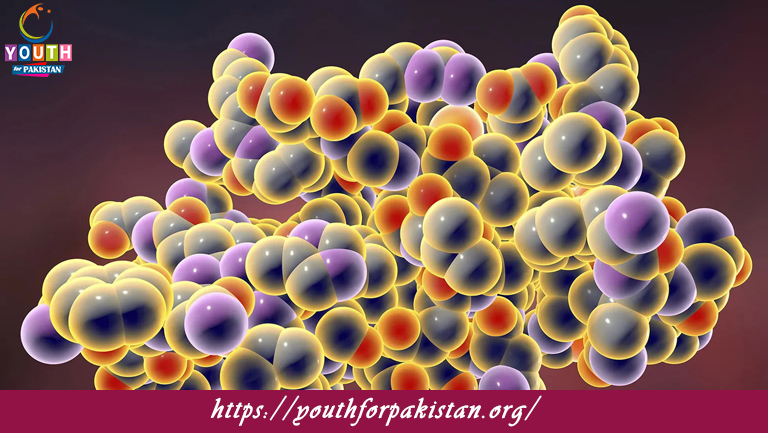Welcome to the Macromolecules MDCAT MCQs with Answers. In this post, we have shared Macromolecules Multiple Choice Questions and Answers for PMC MDCAT 2024. Each question in MDCAT Chemistry offers a chance to enhance your knowledge regarding Macromolecules MCQs in this MDCAT Online Test.
Macromolecules are typically characterized by:
a) Small size
b) Large size
c) High solubility
d) Low molecular weight
Which of the following is a type of macromolecule?
a) Water
b) Glucose
c) DNA
d) Sodium chloride
Proteins, nucleic acids, carbohydrates, and lipids are examples of:
a) Small molecules
b) Micromolecules
c) Macromolecules
d) Inorganic compounds
The primary monomers of proteins are:
a) Nucleotides
b) Amino acids
c) Monosaccharides
d) Fatty acids
Which macromolecule is responsible for storing and transmitting genetic information?
a) Carbohydrates
b) Proteins
c) Lipids
d) Nucleic acids
The macromolecule that serves as the main source of energy for living organisms is:
a) Proteins
b) Carbohydrates
c) Nucleic acids
d) Lipids
What is the main component of cell membranes?
a) Carbohydrates
b) Proteins
c) Lipids
d) Nucleic acids
The macromolecule composed of a glycerol backbone and fatty acid chains is known as:
a) Protein
b) Carbohydrate
c) Nucleic acid
d) Lipid
What type of bond connects monomers in a polymer?
a) Hydrogen bond
b) Ionic bond
c) Covalent bond
d) Van der Waals bond
Which of the following macromolecules is primarily used for energy storage in animals?
a) Starch
b) Glycogen
c) Cellulose
d) Chitin
What type of macromolecule is cellulose?
a) Protein
b) Carbohydrate
c) Lipid
d) Nucleic acid
The sequence of nucleotides in DNA determines:
a) The primary structure of proteins
b) The tertiary structure of proteins
c) The sequence of amino acids in proteins
d) The folding of proteins
The process by which polymers are formed from monomers is called:
a) Hydrolysis
b) Condensation
c) Decomposition
d) Ionization
The primary function of nucleic acids is:
a) Energy storage
b) Structural support
c) Genetic information storage and transmission
d) Enzyme catalysis
What type of macromolecule is insulin?
a) Carbohydrate
b) Lipid
c) Protein
d) Nucleic acid
The macromolecule that provides structural support in plant cell walls is:
a) Starch
b) Glycogen
c) Cellulose
d) Chitin
The monomers of nucleic acids are called:
a) Amino acids
b) Nucleotides
c) Monosaccharides
d) Fatty acids
The basic unit of carbohydrates is:
a) Amino acid
b) Nucleotide
c) Monosaccharide
d) Fatty acid
Which macromolecule is not soluble in water but is soluble in nonpolar solvents?
a) Carbohydrates
b) Nucleic acids
c) Lipids
d) Proteins
The type of bond that links amino acids in proteins is known as:
a) Glycosidic bond
b) Phosphodiester bond
c) Peptide bond
d) Ester bond
Which of the following is a disaccharide?
a) Glucose
b) Fructose
c) Sucrose
d) Cellulose
The building blocks of lipids are:
a) Amino acids and nucleotides
b) Monosaccharides
c) Fatty acids and glycerol
d) Nucleotides
The double helix structure is associated with which macromolecule?
a) Carbohydrates
b) Proteins
c) Nucleic acids
d) Lipids
Which macromolecule is a polymer of nucleotides?
a) Protein
b) Carbohydrate
c) Lipid
d) Nucleic acid
The type of carbohydrate that is used for energy storage in plants is:
a) Glycogen
b) Cellulose
c) Starch
d) Chitin
The macromolecule with a characteristic “backbone” of alternating sugar and phosphate groups is:
a) RNA
b) Protein
c) Carbohydrate
d) Lipid
Which of the following is a function of proteins?
a) Energy storage
b) Genetic information
c) Enzyme catalysis
d) Structural support in cell walls
The macromolecule that is a major component of cell membranes is:
a) Carbohydrate
b) Protein
c) Lipid
d) Nucleic acid
Which macromolecule forms a complex with proteins to facilitate their function?
a) Carbohydrates
b) Lipids
c) Nucleic acids
d) All of the above
What type of bond is formed between the hydroxyl groups of sugars in carbohydrates?
a) Peptide bond
b) Glycosidic bond
c) Ester bond
d) Phosphodiester bond
The energy-storing polysaccharide found in animals is:
a) Cellulose
b) Starch
c) Glycogen
d) Chitin
The main purpose of dietary fiber is to:
a) Provide energy
b) Aid digestion
c) Build muscle
d) Store genetic information
The hydrolysis of proteins results in:
a) Amino acids
b) Nucleotides
c) Fatty acids
d) Monosaccharides
The primary structural support in the exoskeleton of arthropods is provided by:
a) Chitin
b) Cellulose
c) Glycogen
d) Starch
What is the role of enzymes in biochemical reactions?
a) Increase the activation energy
b) Decrease the reaction rate
c) Lower the activation energy
d) Provide energy
The process by which a macromolecule is broken down into smaller units is called:
a) Condensation
b) Hydrolysis
c) Polymerization
d) Dehydration
In nucleic acids, the phosphate group is attached to:
a) The sugar molecule
b) The nitrogenous base
c) The amino acid
d) The fatty acid
The macromolecule that is involved in cell signaling and recognition is:
a) Lipid
b) Protein
c) Carbohydrate
d) Nucleic acid
In which type of macromolecule would you find peptide bonds?
a) Carbohydrates
b) Proteins
c) Nucleic acids
d) Lipids
Which macromolecule is most commonly associated with genetic coding and inheritance?
a) Lipids
b) Carbohydrates
c) Proteins
d) Nucleic acids
If you are interested to enhance your knowledge regarding Physics, Chemistry, Computer, and Biology please click on the link of each category, you will be redirected to dedicated website for each category.








